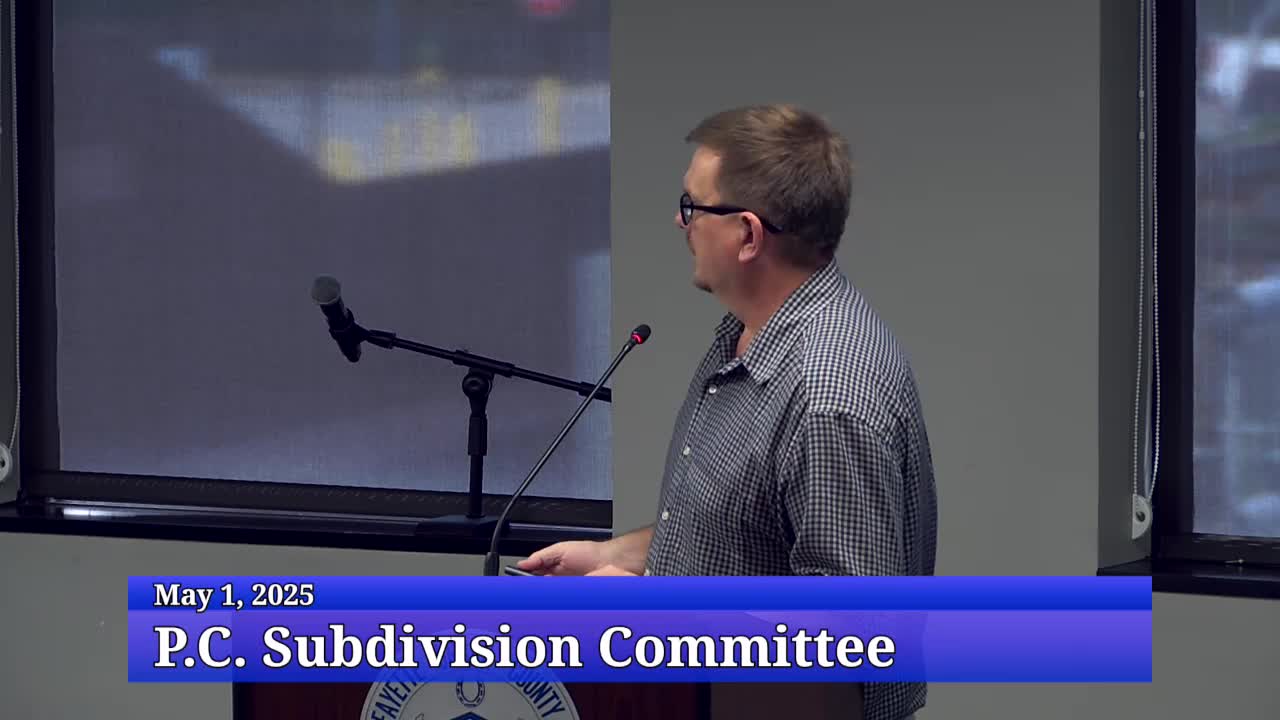Lane Allen Park proposed 25‑lot subdivision postponed as engineers and applicants complete floodplain study and documentation
May 01, 2025 | Lexington City, Fayette County, Kentucky
This article was created by AI summarizing key points discussed. AI makes mistakes, so for full details and context, please refer to the video of the full meeting. Please report any errors so we can fix them. Report an error »

The Subdivision Committee continued discussion and postponed final action on a proposed rezoning and subdivision at Lane Allen Park (M J D P 24‑81), a plan that would create 25 single‑family lots and would change the zoning from R‑1A to planned neighborhood residential (R‑3).
Staff said applicants had submitted revised plans showing floodplain limits and a revised street layout after earlier concerns; remaining staff items include providing a floodplain study compliant with the stormwater manual (including hydraulic models and cross sections suitable for FEMA review), clarifying which lots are affected by calculated floodplain limits, and updating right‑of‑way dedication notes. Committee members asked about a previously documented historic house on the property; applicant counsel said that the house had been removed prior to filing the application and that representatives had met with Bluegrass Trust and other stakeholders, who concluded the structure was not salvageable.
Attorney and applicant representatives told the committee they had provided extensive engineering information to downstream property representatives (including the adjacent church) and that they planned to provide floodplain analysis that goes beyond minimum detention requirements — releasing stormwater more slowly than the minimum standard to mitigate downstream impacts. Staff requested submission of the full HEC‑RAS (or FEMA grade) model with cross sections before certification to verify the floodplain delineation shown on the plans.
The committee voted to postpone the matter to allow the applicant to submit the requested floodplain documentation and to continue outreach with neighbors; the transcript records a motion for postponement and a second and the committee vote in favor.
Why it matters: the site’s proximity to downstream properties and a creek means floodplain delineation and stormwater detention details will affect both on‑site lot layout and potential impacts to downstream neighbors. The applicant said it would provide fuller documentation to verify floodplain lines and mitigation measures.
What’s next: the applicant will submit a floodplain study including hydraulic cross sections and modeling and will continue meetings with neighborhood stakeholders and the adjacent church prior to the next hearing.
Staff said applicants had submitted revised plans showing floodplain limits and a revised street layout after earlier concerns; remaining staff items include providing a floodplain study compliant with the stormwater manual (including hydraulic models and cross sections suitable for FEMA review), clarifying which lots are affected by calculated floodplain limits, and updating right‑of‑way dedication notes. Committee members asked about a previously documented historic house on the property; applicant counsel said that the house had been removed prior to filing the application and that representatives had met with Bluegrass Trust and other stakeholders, who concluded the structure was not salvageable.
Attorney and applicant representatives told the committee they had provided extensive engineering information to downstream property representatives (including the adjacent church) and that they planned to provide floodplain analysis that goes beyond minimum detention requirements — releasing stormwater more slowly than the minimum standard to mitigate downstream impacts. Staff requested submission of the full HEC‑RAS (or FEMA grade) model with cross sections before certification to verify the floodplain delineation shown on the plans.
The committee voted to postpone the matter to allow the applicant to submit the requested floodplain documentation and to continue outreach with neighbors; the transcript records a motion for postponement and a second and the committee vote in favor.
Why it matters: the site’s proximity to downstream properties and a creek means floodplain delineation and stormwater detention details will affect both on‑site lot layout and potential impacts to downstream neighbors. The applicant said it would provide fuller documentation to verify floodplain lines and mitigation measures.
What’s next: the applicant will submit a floodplain study including hydraulic cross sections and modeling and will continue meetings with neighborhood stakeholders and the adjacent church prior to the next hearing.
View full meeting
This article is based on a recent meeting—watch the full video and explore the complete transcript for deeper insights into the discussion.
View full meeting
